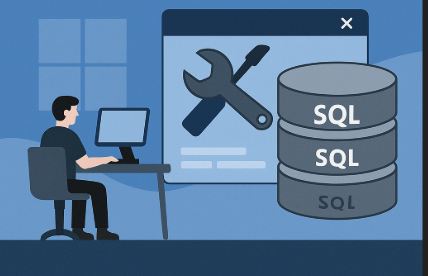How to Repair SQL Table with DBCC CHECKDB?

Strong 8k brings an ultra-HD IPTV experience to your living room and your pocket.
While working with files, data, or database, corruptions can occur. Sometimes the files get corrupted and other times the systems. Today we are going to discuss a similar issue, that is a corrupted SQL table and how to repair SQL table with DBCC CHECKDB. SQL Server provides a built-in tool named DBCC CHECKDB to inspect and repair any corrupted SQL Database.
Along with how this built-in tool will help to repair the corrupted SQL table, this article will also cover the reasons due to which the corruption may occur and the challenges one may face during the repairing process of the SQL table. Let’s start by understanding the basics of the topic to make the write-up easy to understand for the users.
How Does the SQL Table Get Corrupted?
There can be multiple reasons that can lead to the SQL table corruption and forces the users to learn repair SQL table with DBCC CHECKDB. Some of the reasons are mentioned here:
Bugs in SQL Server: If there are any types of bugs present in the SQL Server, this can lead to table data corruption in SQL.
SQL Injection Attack: If the SQL Database has been attacked with SQL Injections, they can target the weak points of the SQL Server and further end up resulting in SQL table corruption.
Backup Issues: If a user takes a backup or restores the data from a corrupted file, it can lead to the corruption of the complete database.
Hardware Issues: If there are any issues in the hardware problems due to sudden power outages or improper shutdowns, they can lead to file or database corruption.
File System Errors: If the file system or the disk storing the SQL database has some issues or gets corrupted, that may also result in the corruption of the complete database including the SQL tables.
So all these reasons somehow contribute to the SQL tables getting corrupted in the SQL Servers. Now the corruption in the SQL tables can be inspected and repaired by using the built-in tool offered by the SQL itself, the DBCC CHECKDB command. But what is this command and how can we repair SQL table with DBCC CHECKDB? Let’s find out.
What is the DBCC CHECKDB Command?
The DBCC (Database Console Command) CHECKDB command is a built-in tool in the SQL Server that helps to check and maintain the database integrity. The major purpose of this command is the maintenance of the SQL Server by identifying and repairing the corruptions present in the SQL Databases. The major functions of this command is to basically check the database integrity, check and inspect for corruptions in the SQL Database and, if found any, then to repair them. Let’s now understand how the repair SQL table with DBCC CHECKDB process works.
How Does the DBCC CHECKDB Command work?
The DBCC command works by following a series of operations. We will now try to understand the operations and learn how the method works.
The first phase of the DBCC command is to detect corruption or damage in the SQL Database. When you first run the DBCC command, it will check the physical and logical structure of the table to detect any corruption present in the table structure.
The second phase of the command will report any corruption or errors found.
If the DBCC command finds any kind of error or corruption in any table or index, it will report the same details so that the DBA can easily spot the issue and resolve it.
Next, the DBCC command offers a few repairing options for different intensity of file damage or corruptions in the SQL database. The users can choose the option as per their necessities and can repair SQL table with DBCC CHECKDB. Let’s understand the repair options now.
REPAIR_FAST
This option helps with minor levels of corruption without disrupting the data integrity within the database.
REPAIR_REBUILD
This option generally helps if there are any logical corruptions in the database or the indexes. The option helps the user to repair and rebuild the corrupted indexes of the tables in the SQL database.
This method is a good solution if the user wants to repair their corrupted data without losing data or compromising the data integrity.
REPAIR_ALLOW_DATA_LOSS
This method is the last resort if the user encounters a severe corruption in their SQL database. This option helps the user in repairing the corrupted database, but doesn’t guarantee the data integrity and can end up losing the complete data.
A user is suggested to use this option only when they don’t have any other solution left to repair the corrupted database.
Now we have understood the basics of how this method works. Now let’s take a look at how the DBCC command will help the user to repair SQL table.
How to Repair SQL Table With DBCC CHECKDB?
To repair a corrupted SQL table, we can use the DBCC CHECKDB command. The method can help us inspect as well as repair the corruptions present in the database. The steps to repair the table corruption are as follows:
Firstly, it's important to set the database in the emergency mode.
Use the command ALTER DATABASE ABC SET EMERGENCY for the same purpose. [Here ABC is taken as an example; replace it according to your database name].
Now, run the DBCC command to check for any corruptions in the file. The command to detect the corruption is: DBCC CHECKDB(ABC).
Now, the database is supposed to be set in the Single-User mode so that it doesn’t get interrupted in between the process by any other user. Use the command:
ALTER DATABASE ABC SET SINGLE_USER to set the database to single user mode.
To repair the corrupted SQL table, the user now has to run the DBCC command with addition to the repair option, based on the intensity of the corruption in the SQL table to repair SQL table with DBCC CHECKDB.
The command is as follows:
Use DBCC CHECKDB(‘ABC’,REPAIR_FAST) command for minor corruptions.
The REPAIR_FAST command will be used with the DBCC command to repair the corruption in the SQL table without disrupting the database integrity.
Use DBCC CHECKDB(‘ABC’,REPAIR_REBUILD) command to rebuild the corrupted indexes in the SQL table.
If both these options fail to repair the corrupted table, use the last resort for repairing the corrupted SQL table. The option is to use the REPAIR_ALLOW_DATA_LOSS.
Use the command:
DBCC CHECKDB(N ‘ABC’, REPAIR_ALLOW_DATA_LOSS) WITH ALL ERROR_MSGS, NO_INFOMSGS;
GO
After the completion of the method, set the database back to the multi-user mode for the other users to access the database again. Use the command:
ALTER DATABASE ABC SET MULTI_USER
This option is suggested to be used only when the other methods have failed to repair SQL table with DBCC CHECKDB. This command can repair the database but there are high risks of data loss during the process.
But Is The Manual Way Really Helpful?
The DBCC CHECKDB command is helpful for the users as it is provided by the SQL to detect and repair the possible corruptions in the SQL database. The tool provides multiple options to repair the corrupted SQL database along with the objects. But this method has some setbacks that may cause issues for the user while implementing the repair commands. We will now discuss the setback of using the repair SQL table with DBCC CHECKDB method.
High Risk of Data Loss: The repair option that helps the user with the major corruptions poses a high risk of losing the data during the repair process. So, it may create new concerns for the users who need to recover their data from a corrupted file or repair a corrupted SQL table.
Unable to Repair All Types of Corruptions: The DBCC CHECKDB command helps the user with detection and repair of the corrupted SQL database along with its objects like tables, views, stored procedures, etc. The command still can help with the physical type of errors present in the SQL database. But when it comes to repairing the logical errors, it gets complicated for the DBCC command to repair those errors too.
Requires Technical Expertise: As we all saw with the steps of the DBCC command, they can be quite complex for the users who are not much aware of the command line tools or who have less technical knowledge about the SQL Server. Hence, to use the repair SQL table with DBCC CHECKDB solution, a user must have sufficient technical knowledge to implement these methods to repair the corrupted SQL table.
Complete Recovery Not Guaranteed: The DBCC command may help to repair the corruptions to some extent, but it does not assure complete recovery of the corrupted SQL database or tables. Therefore, if a user is going to implement the DBCC command for the recovery of their corrupted data, they should take backups beforehand or be prepared for the possible setbacks during the process.
Restricted Database Access: To run the DBCC command to repair the corrupted SQL table without any interruptions, the database is first set to the emergency mode and then to the single user mode to restrict any user from accessing the SQL database during the repair process. This may cause problems for the other users who were working on that specific database.
How to Overcome the Limitations?
The limitations we all encountered while using the repair SQL table with DBCC CHECKDB method, can create many more challenges for the users who are trying to resolve their issues regarding the corrupted SQL tables. That’s why we are here to suggest a solution for the users so that they can resolve their issues without facing any more complexities throughout the recovery process.
The solution we recommend is using the SQL Database Recovery Tool. This tool not only allows the user to repair their corrupt SQL table, but also helps the users with other related issues encountered during the repair SQL table with DBCC CHECKDB process.
Let’s see how this method is better than the manual method and discuss what are the features offered by the tool to help the users in an efficient way. The steps to repair a corrupted table in SQL is as follows:
- Install and open the SQL Recovery Tool. Click on Open to add the MDF files in the recovery tool.
- Choose the scanning mode as per the intensity of the SQL table corruption.
- Once the scanning is completed, preview all the scanned database objects.
- Next, to export the recovered data, click on the export button. Enter the required login and authentication credentials in the provided text fields.
- Choose the destination path from the two given options and proceed with selecting the recovered data that needs to be exported from the software.
- Choose the export with schema and data option and click on save button to export the recovered data.
These are the detailed set of steps for the easy application of the recovery tool to repair the SQL table. By following these simple steps a user can easily recover their data from a corrupted database.
Conclusion
DBCC CHECKDB command is one of the methods that can be used to detect and repair corruptions present in the SQL Server Database. But recently we found out that the repair SQL table with DBCC CHECKDB method had some limitations that were creating issues for the users. These drawbacks were causing challenges that made the repairing process more complex, so to overcome that challenge, we have suggested a solution. This expert recommended tool not only helps the users to detect the intensities of the corruptions, but will also allow the users to recover the corrupted or deleted data from the SQL Database.
Note: IndiBlogHub features both user-submitted and editorial content. We do not verify third-party contributions. Read our Disclaimer and Privacy Policyfor details.







